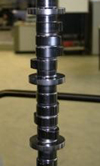DLC coatings with improved properties
 In researching a recent article on this subject in Race Engine Technology (issue 47, June/July 2010), I spoke to many companies and discussed all kinds of coatings. DLC has been around for a number of years now and its use is widespread; however, this coating still attracts a lot of R&D spending for process development.
In researching a recent article on this subject in Race Engine Technology (issue 47, June/July 2010), I spoke to many companies and discussed all kinds of coatings. DLC has been around for a number of years now and its use is widespread; however, this coating still attracts a lot of R&D spending for process development.
The aims of this are generally to produce an improved coating in terms of one or more parameters. It would be considered a worthwhile step forward in coating technology to improve adhesion, reduce the coefficient of friction, minimise wear rates or raise the upper temperature limit at which such coatings will satisfactorily operate without degradation.
In the previous article on surface treatments, ion implantation was discussed. Besides the benefits that this might bestow on a component by virtue of altered composition of the surface or the compressive residual stress it can impart, an important development has been the improved adhesion of coatings which has been observed when followed by 'ion mixing' treatments.
One company has taken the process a stage further and uses an ion implantation process before DLC coating in order to achieve better results. Systec has developed a new family of DLC coatings which offer improvements over other DLC coatings, and I spoke to the company's Val Lieberman about the processes involved and the results.
I asked how the ion implantation stage affected the performance of the subsequent DLC coating, and Lieberman's reply was, "Primarily, the implantation provides better adhesion", but he added, "A side effect is that it increases the load-bearing capacity of surface layers due to the 'hardening' effect of the implantation."
This improved adhesion is borne out by test results on each of Systec's coatings, all of which have improved adhesion compared to competitors' DLC coatings as measured by LC2 critical load testing. LC2 results show the load at which coatings show delamination.

Lieberman pointed to the coating process as being critical in this improvement, saying that the HIPIMS (High Power Impulse Magnetron Sputtering) process produces coatings virtually free from pinhole defects which, he says, are "local coating delaminations" typical in many DLC processes. He suggested that these defects "may act as islands, where local increase in contact temperature may trigger thermal degradation of the DLC".
The three coatings from Systec offer a range of properties, with the hardest and most wear-resistant showing good frictional behaviour (with equal or lower friction than a competitor's DLC) combined with a wear rate as little as 1% of that of another DLC.
Surprisingly, these improved coatings are produced at a lower cost compared to competitor coatings "due to higher processing yields and scaled-up processing," says Lieberman. The coatings are still a step above something like CrN in terms of cost though.
These coatings are being used successfully in motorsport valvetrains and other race engine applications.
The processing temperature is quite low, being in the 200-230 C range, and is suited to any material that is stable at these temperatures, which would include most steels (apart from those tempered at lower temperatures than here, such as most carburising steels), titanium alloys and possibly some aluminium alloys aimed at high-temperature service.
Fig. 1 - This NASCAR camshaft has been coated with a new generation of DLC; the process incorporates ion implantation (Courtesy of Systec SVS Vacuum Coatings)
Written by Wayne Ward